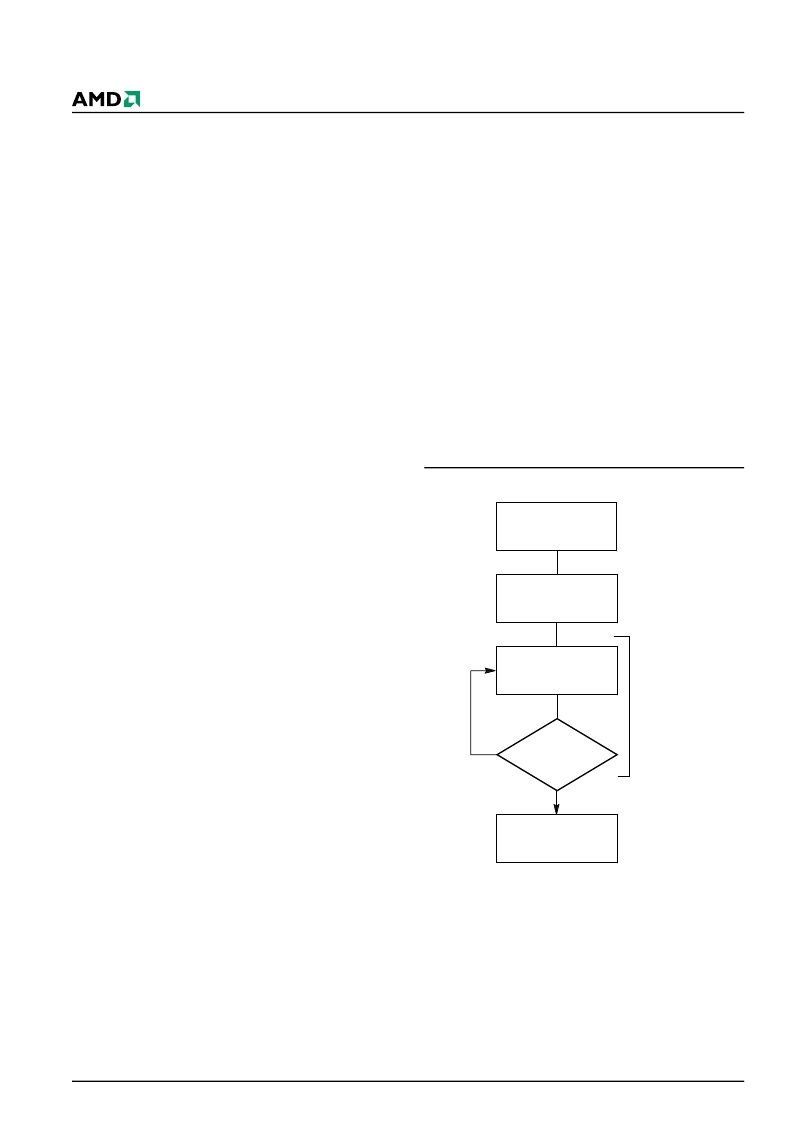- 您現(xiàn)在的位置:買賣IC網(wǎng) > PDF目錄366426 > AM29F040B-90PD (ADVANCED MICRO DEVICES INC) 4 Megabit (512 K x 8-Bit) CMOS 5.0 Volt-only, Uniform Sector Flash Memory PDF資料下載
參數(shù)資料
| 型號: | AM29F040B-90PD |
| 廠商: | ADVANCED MICRO DEVICES INC |
| 元件分類: | PROM |
| 英文描述: | 4 Megabit (512 K x 8-Bit) CMOS 5.0 Volt-only, Uniform Sector Flash Memory |
| 中文描述: | 512K X 8 FLASH 5V PROM, 90 ns, PDIP32 |
| 封裝: | LEAD FREE, PLASTIC, MO-015AP, DIP-32 |
| 文件頁數(shù): | 14/36頁 |
| 文件大小: | 534K |
| 代理商: | AM29F040B-90PD |
第1頁第2頁第3頁第4頁第5頁第6頁第7頁第8頁第9頁第10頁第11頁第12頁第13頁當(dāng)前第14頁第15頁第16頁第17頁第18頁第19頁第20頁第21頁第22頁第23頁第24頁第25頁第26頁第27頁第28頁第29頁第30頁第31頁第32頁第33頁第34頁第35頁第36頁

12
Am29F040B
21445E5
November 1, 2006
D A T A S H E E T
Timer”
section.) The time-out begins from the rising
edge of the final WE# pulse in the command sequence.
Once the sector erase operation has begun, only the
Erase Suspend command is valid. All other commands
are ignored.
When the Embedded Erase algorithm is complete, the
device returns to reading array data and addresses are
no longer latched. The system can determine the sta-
tus of the erase operation by using DQ7, DQ6, or DQ2.
Refer to
“Write Operation Status”
for information on
these status bits.
Figure
2
illustrates the algorithm for the erase opera-
tion. Refer to the Erase/Program Operations tables in
the
“AC Characteristics”
section for parameters, and to
the Sector Erase Operations Timing diagram for timing
waveforms.
Erase Suspend/Erase Resume Commands
The Erase Suspend command allows the system to in-
terrupt a sector erase operation and then read data
from, or program data to, any sector not selected for
erasure. This command is valid only during the sector
erase operation, including the 50 μs time-out period
during the sector erase command sequence. The
Erase Suspend command is ignored if written during
the chip erase operation or Embedded Program algo-
rithm. Writing the Erase Suspend command during the
Sector Erase time-out immediately terminates the
time-out period and suspends the erase operation. Ad-
dresses are “don’t-cares” when writing the Erase
Suspend command.
When the Erase Suspend command is written during a
sector erase operation, the device requires a maximum
of 20 μs to suspend the erase operation. However,
when the Erase Suspend command is written during
the sector erase time-out, the device immediately ter-
minates the time-out period and suspends the erase
operation.
After the erase operation has been suspended, the
system can read array data from or program data to
any sector not selected for erasure. (The device “erase
suspends” all sectors selected for erasure.) Normal
read and write timings and command definitions apply.
Reading at any address within erase-suspended sec-
tors produces status data on DQ7–DQ0. The system
can use DQ7, or DQ6 and DQ2 together, to determine
if a sector is actively erasing or is erase-suspended.
See
“Write Operation Status”
for information on these
status bits.
After an erase-suspended program operation is com-
plete, the system can once again read array data within
non-suspended sectors. The system can determine
the status of the program operation using the DQ7 or
DQ6 status bits, just as in the standard program oper-
ation. See
“Write Operation Status”
for more
information.
The system may also write the autoselect command
sequence when the device is in the Erase Suspend
mode. The device allows reading autoselect codes
even at addresses within erasing sectors, since the
codes are not stored in the memory array. When the
device exits the autoselect mode, the device reverts to
the Erase Suspend mode, and is ready for another
valid operation. See
“Autoselect Command Sequence”
for more information.
The system must write the Erase Resume command
(address bits are “don’t care”) to exit the erase suspend
mode and continue the sector erase operation. Further
writes of the Resume command are ignored. Another
Erase Suspend command can be written after the de-
vice has resumed erasing.
Notes:
1. See the appropriate Command Definitions table for erase
command sequence.
2. See
“DQ3: Sector Erase Timer”
for more information.
Figure 2. Erase Operation
START
Write Erase
Command Sequence
Data Poll
from System
Data = FFh
No
Yes
Erasure Completed
Embedded
Erase
algorithm
in progress
相關(guān)PDF資料 |
PDF描述 |
|---|---|
| AM29F040B-90PE | 4 Megabit (512 K x 8-Bit) CMOS 5.0 Volt-only, Uniform Sector Flash Memory |
| AM29F040B-90PF | 4 Megabit (512 K x 8-Bit) CMOS 5.0 Volt-only, Uniform Sector Flash Memory |
| AM29F040B-90PI | 4 Megabit (512 K x 8-Bit) CMOS 5.0 Volt-only, Uniform Sector Flash Memory |
| AM29F040B-90PK | 4 Megabit (512 K x 8-Bit) CMOS 5.0 Volt-only, Uniform Sector Flash Memory |
| AM29F040 | 4 Megabit (524,288 x 8-Bit) CMOS 5.0 Volt-only, Sector Erase Flash Memory |
相關(guān)代理商/技術(shù)參數(shù) |
參數(shù)描述 |
|---|---|
| AM29F040B-90PF | 制造商:Spansion 功能描述:IC 5V 4M BIT FLASH SECTOR CS39 |
| AM29F080B-120EC | 制造商:Advanced Micro Devices 功能描述: |
| AM29F080B-120EF | 制造商:Spansion 功能描述:NOR Flash Parallel 5V 8Mbit 1M x 8bit 120ns 40-Pin TSOP |
| AM29F080B-120SC | 制造商:Spansion 功能描述:IC,EEPROM,NOR FLASH,1MX8,CMOS,SOP,44PIN,PLASTIC |
| AM29F080B-120SC/T | 制造商:Spansion 功能描述:FLASH PARALLEL 5V 8MBIT 1MX8 120NS 44SOIC - Rail/Tube |
發(fā)布緊急采購,3分鐘左右您將得到回復(fù)。